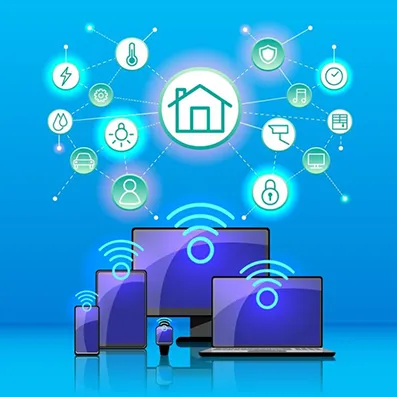Internet of Things definition begins with the idea of enabling everyday objects to send and receive data by connecting to the Internet. Devices such as smart thermostats, wearable health monitors, and wireless inventory trackers fall into this category. IoT facilitates communication between these devices and enhances larger systems, data collection, analysis and automation processes.
Internet of Things definition also plays an important role in smart city projects. In such cities, IoT devices are used to optimize traffic flow, improve public safety, and increase energy efficiency. Devices such as smart street lights, traffic cameras and pollution sensors make cities more livable and manageable while reducing environmental impact. These practices help cities achieve sustainability goals and improve quality of life.

What is a IoT simple definition? The term IoT, short for Internet of Things, refers to the network of physical objects; devices, vehicles, appliances embedded with sensors, software, and other technologies for the purpose of connecting and exchanging data with other devices and systems over the internet. This technology enables devices to interact and cooperate with each other in real-time, making everyday tasks more efficient.
IoT meaning expands beyond mere device connectivity. It signifies a broader shift towards a more interconnected and smart environment where technology and data make systems and processes more efficient and responsive. Here are some key applications:
- Smart home devices such as thermostats and lighting systems,
- Wearable health monitors tracking vital signs,
- Industrial IoT (IIoT) enhancing manufacturing processes.
IoT solutions involve multiple technologies, including:
- Sensors collecting data,
- Cloud computing platforms analyzing data,
- Machine learning algorithms making decisions based on data.
Definition of Internet of Things
The definition of Internet of Things encompasses a vast and dynamically evolving field that impacts various aspects of modern life and industry. At its core, the Internet of Things (IoT) refers to the expansive network of devices equipped with sensors, software, and connectivity, which allows them to collect and exchange data, making them responsive. The full form of IoT reveals its capacity to integrate digital and physical processes, enhancing the efficiency, accuracy, and productivity of various systems.
What is IoT exactly? It’s a concept that extends connectivity beyond conventional devices like computers and smartphones to a wide range of everyday objects. This connectivity enables devices to communicate and interact over the internet, and they can also be remotely monitored and controlled.
What are examples of IoT? Common instances include:
- Smart appliances in homes that automate tasks
- Wearable health devices that monitor vital signs
- Smart city technologies that manage everything from traffic to environmental monitoring
In the industrial sphere, Industrial Internet or IIoT (Industrial Internet of Things) plays a pivotal role. IIoT refers to the application of IoT technology in manufacturing and other industrial sectors. It emphasizes high levels of system connectivity, data acquisition, and automation. The outcomes are profound, offering substantial improvements in operational efficiency and reliability in sectors as diverse as manufacturing, logistics, and agriculture.

The diagram of an IoT system typically illustrates various components from sensors and communication networks to data processing applications and user interfaces. This depiction helps to understand the complex and interconnected nature of IoT systems.
The phrase dynamic global perfectly describes the IoT’s ever-evolving nature. As technology advances, so too does the capability of IoT systems to adapt to new challenges and environments, making it a pivotal technology in the ongoing digital transformation.
Thus, the IoT definition reflects a broad and deep impact across multiple sectors, powered by the continual integration of new technologies and processes. Whether it’s enhancing personal convenience or transforming industrial operations, IoT stands at the forefront of technological innovation.

